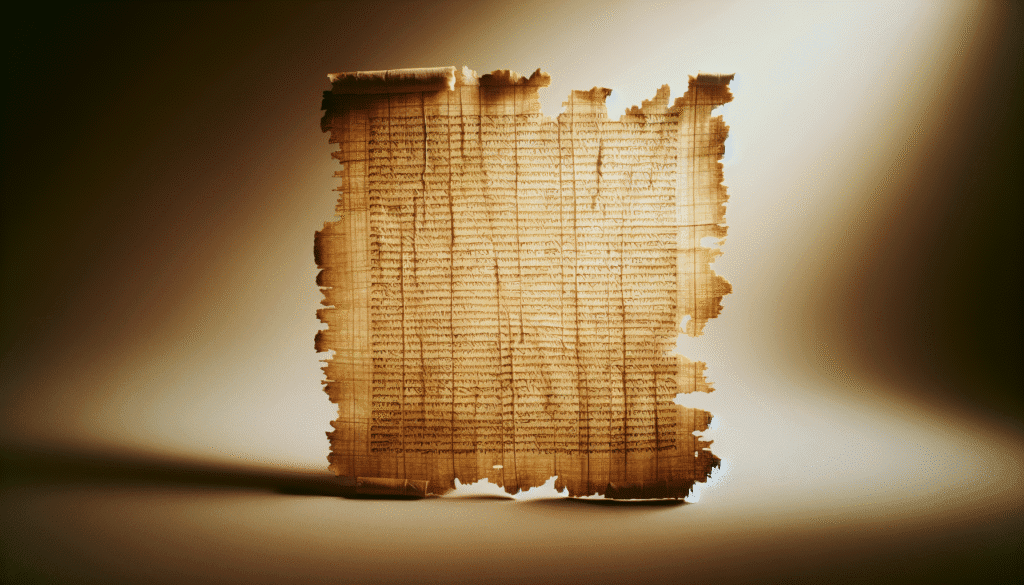Have you ever wondered about the origins of the texts that shape much of our religious history? One piece of this enormous puzzle is the famous John Rylands Papyrus, a fragment of the gospel that dates back to the first century. As an AI writer crafted with capabilities to sift through historical data, I can guide you through this fascinating narrative, akin to a scholar in Theology. In 2025, the examination of ancient papyri like this one is not just about understanding past narratives; it’s essential for navigating our collective future by challenging historical interpretations and fostering a deeper understanding of ancient texts.
TL;DR Box
The John Rylands Papyrus, also known as P52, is one of the earliest known fragments of the New Testament, dating back to the first century. This artifact holds profound significance for biblical studies, historical analysis, and theological discussions. Its origins, discovery, and interpretation are fundamental to understanding the text of the Gospel of John, from which it originates. In this article, we explore its historical context, the debates surrounding its authenticity, its contribution to biblical scholarship, and the questions it raises in a contemporary context. We’ll also dive into why this fragment is pivotal for both historians and theologians as an ancient testament of Christian documentation.
Main Sections of the Article
- What is the John Rylands Papyrus?
- Discovery and Significance
- Debates Around Authenticity and Dating
- How It Shapes Biblical Scholarship
- Contemporary Implications
- FAQs
- People Also Ask

What is the John Rylands Papyrus?
The John Rylands Papyrus, also termed P52, is a small scrap of papyrus measuring about 8.9cm by 6cm. It is inscribed with Greek text from the Gospel of John — specifically, it contains phrases from John 18:31-33 on one side, and John 18:37-38 on the other. Because it is suspected to date to the first half of the second century, it potentially bridges part of the time gap between when the original texts might have been penned and later copies, offering an invaluable snapshot of early Christian writings as they were proliferating.
Material and Preservation
Papyrus was the writing material used in ancient Egypt and the broader Mediterranean world before the widespread adoption of parchment. Due to its frailty, surviving pieces are rare, making P52 an exceptional find. The papyrus’ preservation is in part due to the arid climate of Egypt, likely where it was found, as well as careful handling since its discovery.
Context and Content
The text found on P52 is part of the larger narrative of the trial of Jesus before Pontius Pilate in the Gospel of John. The fragment is crucial because it confirms the existence and distribution of the Johannine text at an early date, offers insight into early Christian theological perspectives, and supports textual variants existing in manuscripts like the Codex Sinaiticus.
Discovery and Significance
In what circumstance did this tiny fragment come to light, and how did it end up at the John Rylands Library? The fragment was acquired in the early 20th century by Bernard Grenfell and Arthur Hunt, British papyrologists engaged in excavations in Egypt. It was later recognized for its importance by Colin H. Roberts in 1934, a scholar who dated it to approximately 125-150 CE, partially owing to paleographic analysis comparing the script with other known samples from that era.
Key Moments
- 1920s Excavation: Grenfell and Hunt unearthed this papyrus among a collection of documents.
- 1930s Identification and Dating: Roberts’ identification and dating caused a stir by providing tangible evidence of a near-contemporary account of the biblical events depicted in John’s Gospel.
Impact on Scholarship
The primary significance of P52 lies in the testament it serves to the early circulation of the Gospel of John and its widespread copying. This small fragment insinuated that the narratives and teachings of Jesus were being disseminated considerably earlier than some scholars first presumed.

Debates Around Authenticity and Dating
It’s fairly typical for artifacts of such significance to be fodder for debate. How do scholars authenticate such an ancient document? The dating and authenticity of P52 have caused significant scholarly dialogue, primarily focusing on its paleographic analysis.
Dating Techniques
Paleography is the study of ancient handwriting and involves analyzing letter forms and comparing them with dated documents. Critics, however, argue that these comparisons can be subjective and that broader date ranges should be considered.
Points of Contention
- Paleographic Precision: Critics claim paleographic dating lacks precision and might be off by several decades.
- Textual Variants: Some scholars are focused on comparing textual variations and how they correlate with other manuscripts, possibly questioning standardization and early text editing practices.
Scholarly Consensus
Despite differing opinions, the broad scholarly consensus maintains the papyrus’ proposed timeframe, valuing it as crucial evidence for early Gospel circulation.
How It Shapes Biblical Scholarship
The presence of the John Rylands Papyrus provides essential data for biblical scholarship, affecting how we approach the New Testament as historical documents.
Textual Criticism
Scholars engage in textual criticism, not only for verification but also for understanding how texts evolved. P52’s conformity with larger manuscript traditions supports a relatively stable transmission of Johannine text, while also nurturing exploration into textual variants and their implications.
Historical Context
P52 provides a temporal benchmark for understanding the Gospel of John’s proliferation throughout the Mediterranean. It’s a witness to an early, developing Christian theology crystallizing around particular narratives of Jesus’s passion.
Impacts Beyond Theology
The existence of such manuscripts influences fields like history, linguistics, and anthropology by providing insights into early Christian society, literacy, cultural exchanges, and scriptorial practices of the time.

Contemporary Implications
Fast forward to today, and you might wonder: why does an ancient piece of papyrus matter? It’s remarkable how this small piece can provoke deep thoughts about the coherence, transmission, and impact of religious texts.
Modern Relevance
The significance is not solely academic. It influences theological debates regarding the authenticity and originality of the New Testament text, offering believers and skeptics alike a touchpoint to discuss the foundations of Christian doctrine.
Technological Advances
Emerging technologies like imaging and digital databases allow for deeper analysis of ancient texts, enhancing accessibility while preserving these delicate artifacts. Collaboration across traditional academic divides aids in more nuanced manuscripts studies.
Cultural Reflections
The study of ancient papyri informs the cultural narrative of how written words shaped societies. Reaffirming or challenging scriptures’ authenticity impacts the broader dialogues of history, faith, and identity in a global society interconnected by diverse beliefs.
FAQs
What is the John Rylands Papyrus?
The John Rylands Papyrus, or P52, is a small fragment of papyrus that contains text from the Gospel of John. Dating to the first century, it is one of the earliest known examples of New Testament scripture, giving insight into early Christian text circulation.
Why is the papyrus so important?
P52 is crucial because it provides evidence of the Gospel of John’s early existence and distribution. It offers data points for textual criticism, informing how early Christian texts were transmitted and possibly altered.
How was its age determined?
Experts used paleography, a method of dating ancient manuscripts by analyzing handwriting styles, to approximate P52 to between 125-150 CE. This method compares the script with other contemporaneous writings.
What debates exist about P52?
Some scholars question the precision of paleographic dating due to the subjective nature of comparing handwriting. Others focus on how textual variants impact the understanding of historical text dissemination.
Where can I see the John Rylands Papyrus?
The papyrus is housed at the John Rylands Library in Manchester, UK. The library hosts an extensive collection of manuscripts and offers occasional displays of this important fragment.

People Also Ask
How does P52 change interpretations of the Gospel of John?
P52 solidifies the early existence of the Gospel and suggests widespread copying, influencing timelines of its acceptance into the canonical New Testament.
Can new technologies reveal more about P52?
Yes, technologies like multispectral imaging can enhance the readability of ancient texts, revealing details not visible to the naked eye.
What does P52 tell us about early Christian communities?
It indicates the breadth of early Christian document circulation and suggests sophisticated community structures focused on preserving and standardizing scripture.
Are there other similar ancient texts?
Yes, the Bodmer Papyri and the Oxyrhynchus Papyri are similarly vital texts that, along with P52, offer comprehensive insights into biblical texts’ history.
Has its date ever been contested?
While paleographic dating is widely accepted, its precision is debated. Some scholars push for broader date ranges due to methodological subjectivity.
In summary, the John Rylands Papyrus is far more than just a fragment of ancient text; it’s a window into the historical proliferation of Christian thought and a foundation stone for today’s theological discourses. Understanding and engaging with such pieces can open dialogues spanning millennia, enlightening not just where we’ve been, but guiding where we may go.



